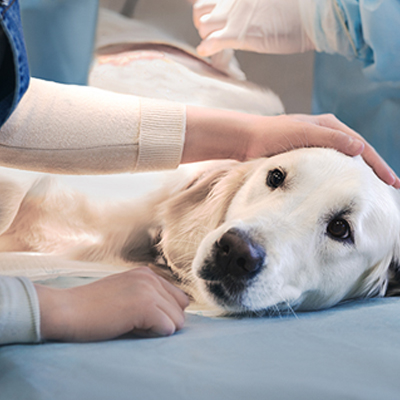What is an ovary sparing spay?
An Ovary sparing spay is where one or both ovaries are left in the abdomen, near the kidneys, but the uterus and cervix are removed. Because the uterus is removed, the female will not be able to become pregnant, even if mating occurs. The female will still have heat cycles and be attractive to male dogs. She will have little to no bloody discharge during her heat cycles.
The main features of ovary sparing spay are:
- Removing uterus and some part of the cervix
- Leaves at least one ovary if not both ovaries
- Hormones are maintained
- Has a heat cycle and may have a very small amount of bloody discharge and will still be attractive to male dogs
- Not fertile
To read more about the other fertility treatments and reproduction services we offer, click here.
Some studies have shown:
- Lower incidence of hemangiosarcoma (cancer usually found in the spleen or heart)
- Lower incidence of osteosarcoma (bone cancer)
- Lower risk of transitional cell carcinoma (bladder cancer)
- Lower incidence of obesity, which may be due at least partly to increased metabolic rate
- Lower incidence of urinary incontinence (equivocal if females are spayed after 5 months but before their first heat)
- Lower incidence of urinary tract infection
- Lower incidence of autoimmune thyroiditis and hypothyroidism
- A reduced incidence of cranial cruciate rupture
- A reduced incidence of hip dysplasia in female dogs that are not spayed before 5 months of age
- Lower incidence of adverse reactions to vaccines
- Less aggression towards people and animals
- A decreased incidence of cognitive dysfunction
- Less fearfulness, noise phobias, and undesirable sexual behaviours
<10kg = £400
10-25kg = £450
25-45kg = £500
>45kg = £550

Some studies have shown:
-
- Lower incidence of hemangiosarcoma (cancer usually found in the spleen or heart)
-
- Lower incidence of osteosarcoma (bone cancer)
-
- Lower risk of transitional cell carcinoma (bladder cancer)
-
- Lower incidence of obesity, which may be due at least partly to increased metabolic rate
-
- Lower incidence of urinary incontinence (equivocal if females are spayed after 5 months but before their first heat)
-
- Lower incidence of urinary tract infection
-
- Lower incidence of autoimmune thyroiditis and hypothyroidism
-
- A reduced incidence of cranial cruciate rupture
-
- A reduced incidence of hip dysplasia in female dogs that are not spayed before 5 months of age
-
- Lower incidence of adverse reactions to vaccines
- Lower incidence of adverse reactions to vaccines
-
- Less aggression towards people and animals
-
- A decreased incidence of cognitive dysfunction
-
- Less fearfulness, noise phobias, and undesirable sexual behaviours
<10kg = £400
10-25kg = £450
25-45kg = £500
>45kg = £550





